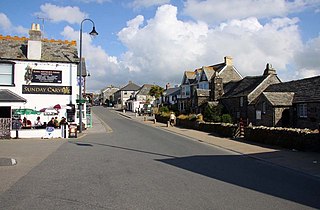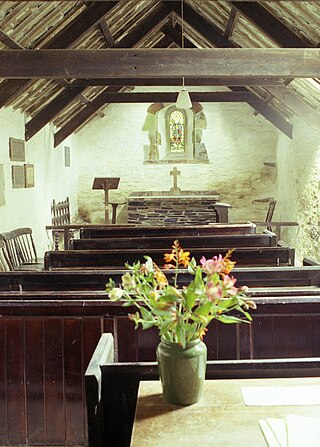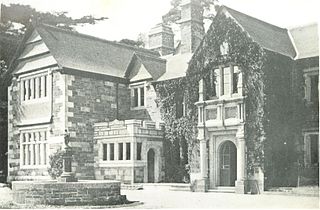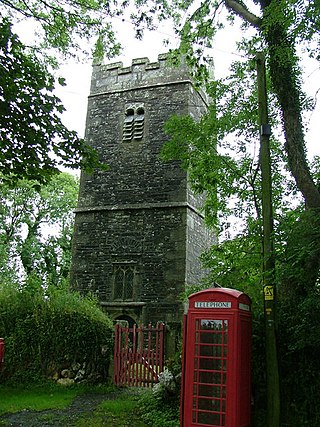
Tintagel or Trevena is a civil parish and village situated on the Atlantic coast of Cornwall, England, United Kingdom. The village and nearby Tintagel Castle are associated with the legends surrounding King Arthur and in recent times have become a tourist attraction. It was claimed by Geoffrey of Monmouth that the castle was an ancient residence of King Arthur.

North Cornwall is an area of Cornwall, England, United Kingdom. It is also the name of a former local government district, which was administered from Bodmin and Wadebridge 50.516°N 4.835°W. Other towns in the area are Launceston, Bude, Padstow, and Camelford.

Boscastle is a village and fishing port on the north coast of Cornwall, England, in the civil parish of Forrabury and Minster. It is 14 miles (23 km) south of Bude and 5 miles (8 km) northeast of Tintagel. The harbour is a natural inlet protected by two stone harbour walls built in 1584 by Sir Richard Grenville and is the only significant harbour for 20 miles (32 km) along the coast. The village extends up the valleys of the River Valency and River Jordan. Heavy rainfall on 16 August 2004 caused extensive damage to the village.

Lesnewth is a civil parish and village in Cornwall, England, United Kingdom. It is about six miles east of Tintagel Head and two miles east of Boscastle.

St Juliot is a civil parish in north-east Cornwall, England, United Kingdom. The parish is entirely rural and the settlements within it are the hamlets of Beeny and Tresparrett. - plus a part of the adjacent village of Marshgate. The parish population at the 2011 census was 328.

Saint Piran's Chapel is a long, single storey slate construction in the hamlet of Trethevy in the parish of Tintagel, Cornwall, UK. It is a chapel-of-ease in the Anglican parish of Tintagel.
Trethevy is a hamlet in north Cornwall, England, United Kingdom.

Saint Nectan's Glen is an area of woodland in Trethevy near Tintagel, north Cornwall stretching for around one mile along both banks of the Trevillet River. The glen's most prominent feature is St Nectan's Kieve, a spectacular sixty foot waterfall through a hole in the rocks. The site attracts tourists who believe it to be "one of the UK's most spiritual sites," and tie or place ribbons, crystals, photographs, small piles of flat stones and other materials near the waterfall.

Forrabury and Minster is a civil parish on the north coast of Cornwall, England, United Kingdom. The parish was originally divided between the coastal parish of Forrabury and inland parish of Minster until they were united on the 1st of April 1919.
Lesnewth Hundred is one of the former hundreds of Cornwall, Trigg was to the south-west and Stratton Hundred to the north-east. Tintagel, Camelford, Boscastle, and Altarnun were in the Hundred of Lesnewth as well as Lesnewth which is now a hamlet but in pre-Norman times was the seat of a Celtic chieftain who was said to rule the whole of Trigg.

Slaughterbridge, Treague and Camelford Station are three adjoining settlements in north Cornwall, England. They straddle the boundary of Forrabury and Minster and Lanteglos by Camelford civil parishes just over a mile (2 km) north-west of the market town of Camelford.

The Parish Church of Saint Materiana at Tintagel is a Church of England parish church in the Church of England Diocese of Truro in Cornwall, England, UK. It stands on the cliffs between Trevena and Tintagel Castle and is listed Grade I.

Lewtrenchard is a village and civil parish in the West Devon district, in the county of Devon, England. Most of the larger village of Lewdown is in the parish. In the Domesday Book of 1086, a manor of Lew is recorded in this area and two rivers have the same name: see River Lew. Trenchard comes from the lords of the manor in the 13th century.

The civil parishes to which the Forrabury and Minster parish churches belong were united in 1919 to form Forrabury and Minster parish, within Cornwall, England, UK. The main settlement in the parish is Boscastle. The two rectories had been united in 1800.

Menefrida is the 5th-century Cornish saint associated with the parish of St Minver, near the Camel estuary in Cornwall, England. Alternative spellings of her name include Menefreda, Menwreda, Menfre, Mynfreda and Minefreda. At the time of King Henry VIII the parish was known as St. Menifryde.
Saint Madron or Maddern was a Pre-Congregational Saint, monk and hermit.

St Julitta's Church, St Juliot is a Grade II* listed parish church in the Church of England Diocese of Truro in St Juliot, Cornwall.

St Michael and All Angels’ Church, Lesnewth is a Grade II* listed parish church in the Church of England in Lesnewth, Cornwall.

St Denis's Church, Otterham is a Grade II* listed parish church in the Church of England Diocese of Truro in Otterham, Cornwall.

Saint Julitta, or Saint Juliot, is a male Celtic saint to whom two Cornish churches are dedicated. He is believed to have settled at the site of Tintagel Castle at the end of the 5th century and established a small monastic community. In some accounts he is a member of the Children of Brychan and St Nectan and the holy female Hermit, St Keyne, are thought to have been his companions. He is the patron of the parish churches of St Juliot and of Lanteglos by Camelford. The Norman chapel of Tintagel Castle is dedicated to St Julitta. At Jetwells near Camelford is a holy well. Jetwells derives from "Juliot's well".


















